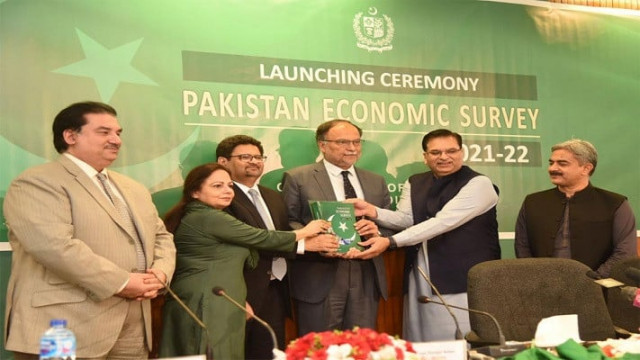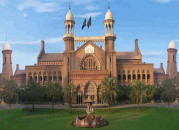Finance Minister Miftah Ismail unveils Pakistan Economic Survey
Finance minister says govt to focus on sustainable economic growth

Finance Minister Miftah Ismail unveiled the Pakistan Economic Survey for Financial Year 2021-22 on Thursday as he underlined the need for “sustainable economic growth” in the upcoming financial year.
#Live: Minister for Finance and Revenue Miftah Ismail presents Economic Survey for the outgoing financial year 2021-22 in Islamabad https://t.co/LGI25NbaBS @betterpakistan @kdastgirkhan @FinMinistryPak @AishaGPasha #EconomicSurvey
— Radio Pakistan (@RadioPakistan) June 9, 2022
The survey was revealed by the finance minister alongside Planning Minister Ahsan Iqbal, State Minister for Finance Ayesha Ghous Pasha, and Power Minister Khurram Dastgir during a press conference in Islamabad.
As per the survey, the economic growth of Pakistan was recorded at 5.97pc as opposed to the target of 4.8pc.
Similarly, the agri sector posted a growth of 4.40pc against a target of 3.5pc; industries posted growth of 7.19pc against the target of 6.5pc, services industry 6.19pc; and services industries recorded 6.19c growth against their target of 4.7 per cent.
During the presser, Miftah said the economy was on the road to stability. He added that the government would ensure sustainable growth in order to reduce the current account deficit.
Speaking about the gas crisis, Miftah said there would have been no gas crisis in the country had the PTI government signed long-term agreements for LNG like the PML-N.
About the foreign direct investments, he said the investments dropped to $1.25 billion in the outgoing financial year against last year’s $2 billion.
The finance minister added that the PML-N government saved Pakistan from the default after coming to power and that the tax-to-GDP ratio will remain at 11.1 per cent. He further said that Pakistan will need to allocate Rs3,900 billion for debt-servicing in the upcoming financial year.
According to the minister, the foreign exchange reserves of Pakistan would improve by $2.4 billion to over $12 billion by early next week. “The reserves would increase after China rolls over $2.4 billion,” Miftah added.
'Rebasing of economy'
Planning Minister Ahsan Iqbal attributed the growth witnessed in the outgoing financial year to rebasing of the economy by the PTI government last year. He added that the former government slashed the Public Sector Development Budget (PDSP) to Rs500 billion.
He said the private sector investment in Pakistan depended on the money invested by the government in the public sector development projects. Iqbal added that in 2021-22, Rs900 billion was set aside for development projects, later it was slashed to Rs700b and then to Rs550b.
Iqbal criticised the former government for damaging the CPEC projects. He added that the PML-N government had established nine Special Economic Zones but the PTI government failed to start work on five zones.
He added that the PML-N had expedited the work started by the PTI on dam projects. He added that industrial development, transport and communication were being focused on in the upcoming year.
Power Minister Khurram Dastgir spoke about power production during the PML-N rule from 2013-18, and said the PTI failed to add anything to the national grid during its rule.
“Had the PTI government set up the required 8,000MW projects, there would be no power outages today,” he added.
According to Dastgir, K-Electric’s 1250MW project using coal produced in Thar was also delayed. The minister added that the government would install power plants that would use indigenous energy for production to ease the balance of payment crisis.
In response to a question, Miftah said the IMF programme will likely resume after the budget. He added that the government shared everything with the Fund to ensure transparency and bridge the trust deficit.
The finance minister said the economic growth through upgrading the agri sector would be sustainable and that the government would also increase the salaries of the state employees to offset the impact of inflation.
He claimed that the government would not make any “unnecessary expenditures” and that it was available to be held accountable for budget expenditure.
“We will definitely announce an increase in salaries of the employees amid a record increase in inflation,” he said, adding that the petrol quota of government high-ups had been slashed as well to cut down on expenses.
Economic survey at a glance
– The real GDP posted a growth of 5.97pc
– For July-April FY2022, the current account deficit remained $13.8 billion against the deficit of $0.5 billion last year
– Investment to GDP ratio remained 15.1pc compared to 14.6pc recorded in FY2021.
– The agriculture sector posted growth of 4.4pc mainly due to 6.6pc growth in crops and 3.3pc growth in livestock.
– Industrial sector recorded a growth of 7.2pc in FY2022 compared to 7.8pc growth in FY2021.
– Services sector still constitutes the largest share of 58pc in GDP
– Large Scale Manufacturing (LSM) growth during July-March FY2022 increased by 10.4pc as compared to 4.2pc growth in the same period last year.
– Total revenues increased by 17.7pc and reached Rs 5,874.2 billion (8.8pc of GDP) in July-March FY2022 against Rs 4,992.6 billion (8.9pc of GDP) last year.
– Total tax collection (Federal & Provincial) grew by 28.1pc to reach Rs 4,821.9 billion during July-March FY2022 as compared to Rs 3,765.0 billion in the comparable period of last year.
– Non-tax revenues, on the other hand, fell 14.3pc to Rs 1,052.2 billion in July-March FY2022, compared to Rs 1,227.6 billion in the same period the previous year.
– Total expenditures grew by 27.0pc to reach Rs 8,439.8 billion in July-March FY2022 against Rs 6,644.6 billion last year.
– Current expenditures grew by 21.2pc to Rs 7,378.0 billion during July-March FY2022 as compared to Rs 6,085.4 billion in the comparable period of last year.
– Total development expenditure increased significantly by 54.6pc to Rs 1,032.7 billion in July-March FY2022 against Rs 668.0 billion in the comparable period of last year.
– The federal PSDP grew by 28.1pc to Rs 452.3 billion during July-March FY2022 against Rs 353.0 billion last year.
– FBR tax collection during July-May FY2022 increased by 28.4pc to Rs 5,348.2 billion against Rs 4,164.3 billion last year.
– During July-March FY2022, all the four provinces posted a combined surplus of Rs 599.8 billion against Rs 412.7 billion in the same period of last year.
– The fiscal deficit increased to 3.8pc of GDP (Rs 2,565.6 billion) during July-March FY2022 against 3.0pc of GDP (Rs 1,652.0 billion) in the same period of last year.
– The primary balance posted a deficit of Rs 447.2 billion against the surplus of Rs 451.8 billion during the period under review.
– During the period 1st July-20th May FY2022, the Net Domestic Assets (NDA) of the banking system witnessed an expansion of Rs 3,075.2 billion as compared to an expansion of Rs 645.7 billion during the comparable period last year.
– The benchmark KSE-100 index opened at 47,356 points on July 1, 2021, closed at 44,929 points on March 31, 2022, and declined by 5.1pc in the first nine months of FY2022.
– The headline inflation CPI averaged 11.3pc during July-May FY2022 against 8.8pc in the comparable period last year.
– During July–April FY2022, the exports grew remarkably by 27.8pc and reached $ 26.8 billion dollars as compared to $ 21.0 billion in the same period last year.
– Imports stood at $ 59.8 billion in July-April FY2022 as compared to $43.0 billion in the same period last year grew by 39.0pc. The increase in imports is recorded in all the major groups.
– Trade deficit increased by 49.6pc in July-April FY2022 to $ 32.9 billion as compared to $ 22.0 billion in the corresponding period last year.
– During July-April FY2022, the current account posted a deficit of $ 13.8 billion against a deficit of $ 543 million last year.
– Total public debt was Rs 44,366 billion at end-March 2022.
– Domestic debt was Rs 28,076 billion and external public debt was Rs 16,290 billion or $ 88.8 billion at the end of March-2022.
– Total labour force is 71.76 million, out of which 67.25 million are employed and 4.51 million are unemployed.
– Import bill of oil increased by 95.9v to $17.03 billion during July-April FY2022 compared to $8.69 billion during the same period last year.



















COMMENTS
Comments are moderated and generally will be posted if they are on-topic and not abusive.
For more information, please see our Comments FAQ